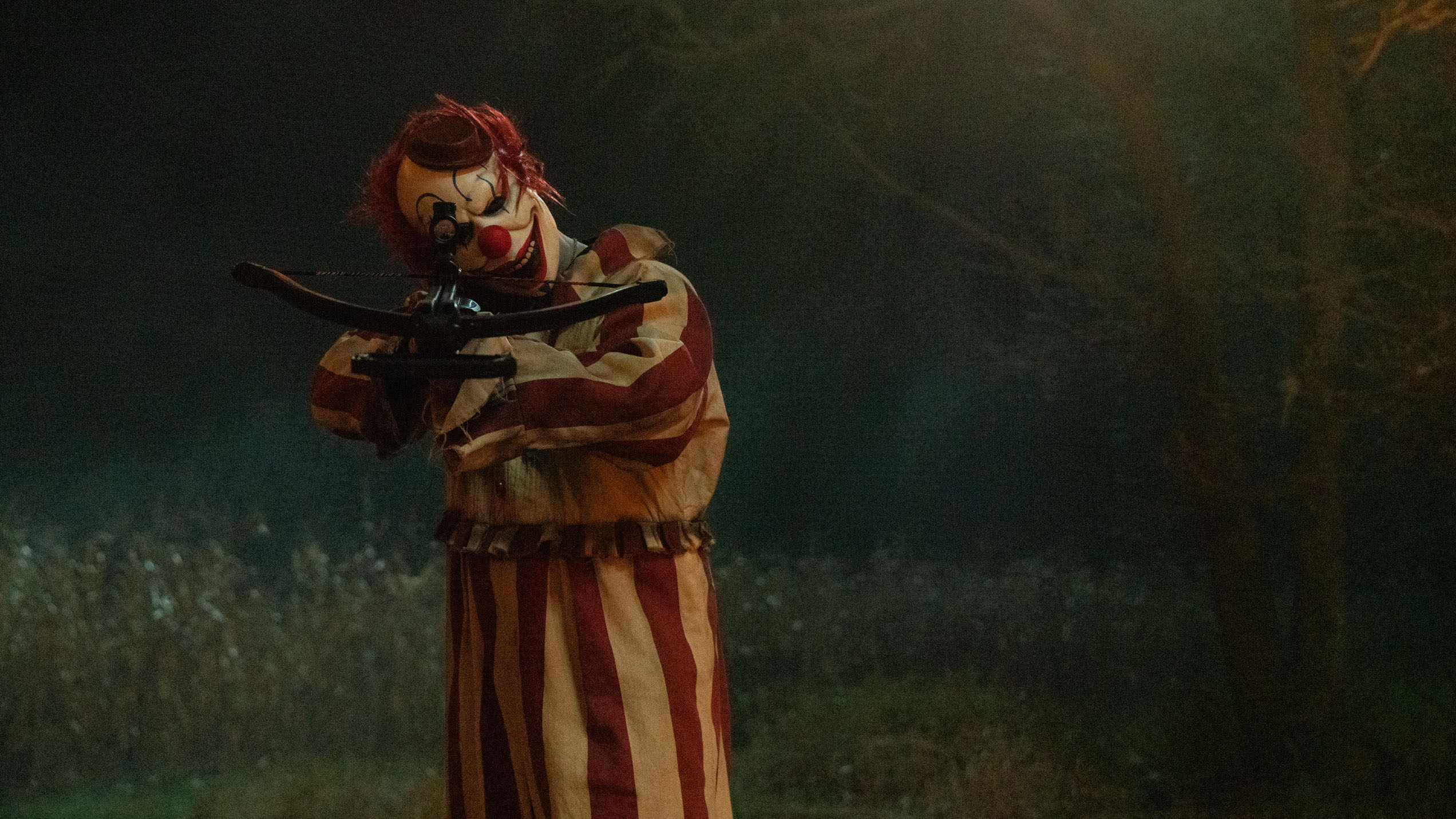Field of Screams

‘Clown in a Cornfield’ Harvests Generational Terror
Writer Joseph J. Airdo // Phoenix Film Critics Society
The slasher film, that most formulaic of horror subgenres, periodically requires revitalization to remain culturally relevant. “Halloween” channeled suburban anxieties in the 1970s, “Scream” deconstructed genre conventions in the 1990s, and now “Clown in a Cornfield” updates the form for an era defined by generational discord and economic displacement.
Director Eli Craig, who previously skewered horror tropes in the cult favorite “Tucker and Dale vs. Evil,” takes a more straightforward approach with this adaptation of Adam Cesare’s novel. Yet beneath its familiar framework — teenagers, a small town with dark secrets, a masked killer — lies a surprisingly potent examination of America’s generational divide.
The film introduces us to Quinn Maybrook (Katie Douglas) and her father, Glenn (Aaron Abrams), who relocate to the struggling town of Kettle Springs, Missouri, seeking a fresh start after personal tragedy. What they find instead is a community fractured along generational lines. The closure of the town’s corn syrup factory has left older residents bitter and resentful, while the younger generation chafes under their restrictive moral codes and backward-looking nostalgia.
When Frendo — the factory’s once-beloved clown mascot—begins a murderous rampage, the film’s central metaphor crystallizes: The older generation, embodied by this distorted symbol of past prosperity, has turned violently against the youth they blame for their problems. It’s a premise ripe with potential, and for its first two acts, “Clown in a Cornfield” delivers on it with surprising nuance.
Katie Douglas proves a compelling protagonist, bringing emotional depth to Quinn that transcends the typical “final girl” archetype. Her scenes with Abrams feel authentically fraught with the tension between parental protection and adolescent independence. Among the supporting cast, Kevin Durand stands out as Arthur Hill, the factory’s former owner, delivering a performance that walks the fine line between sympathetic and sinister.
Visually, the film makes excellent use of its rural setting. Cinematographer Brian Pearson transforms the cornfield — that most American of landscapes — into a disorienting maze where danger lurks behind every stalk. The sequences set within these rows are genuinely unnerving, playing on primal fears of disorientation and pursuit. The production design deserves special mention for Frendo’s mask and costume, which evokes a perverted Americana that perfectly encapsulates the film’s themes.
Where “Clown in a Cornfield” occasionally stumbles is in balancing its social commentary with genre requirements. As the body count rises in the third act, some of the film’s more thoughtful elements get sacrificed for spectacle. The kills, while inventively staged and satisfyingly gory, sometimes undercut the more substantive ideas the film introduces. A particularly jarring tonal shift in the climax, while undeniably crowd-pleasing, feels somewhat at odds with the film’s earlier restraint.
Yet even when its reach exceeds its grasp, there’s something admirable about a slasher film that aims for relevance beyond its set pieces. The screenplay by Carter Blanchard and Craig contains moments of genuine insight about intergenerational resentment. In one standout scene, a teenager’s dismissal of the town’s economic woes as “not my problem” is juxtaposed against an older resident’s refusal to acknowledge changing social norms—each generation blind to its own self-absorption.
The film also deserves credit for avoiding simplistic moral positioning. Neither generation emerges as entirely heroic or villainous; instead, “Clown in a Cornfield” suggests that the real horror lies in our collective inability to see beyond our own perspectives. This complexity elevates it above many entries in the genre that rely solely on their kill sequences for impact.
In a recent conversation for the Images Arizona Podcast, Craig described the film as being “about housing inequality at its core” — a statement that initially seems hyperbolic but gains credence when viewing the film through the lens of economic anxiety. The cornfield itself becomes a powerful symbol for America’s heartland values under threat, while the corn syrup factory represents the hollow sweetness of industrial prosperity that has since turned toxic.
“Clown in a Cornfield” isn’t perfect. Some characters remain underdeveloped, certain plot twists strain credibility, and the film occasionally indulges in the very slasher clichés it seems poised to subvert. But in a genre where originality is increasingly rare, its ambition deserves recognition. By grounding its horror in genuine societal tensions, it achieves a relevance that most contemporary slashers lack.
For fans of intelligent horror that doesn’t sacrifice visceral thrills, “Clown in a Cornfield” offers a satisfying balance. It stands as proof that even the most well-worn genres can still produce works of substance when approached with conviction and cultural awareness. In an era when generational warfare plays out daily on social media, there’s something cathartic about seeing these tensions literalized through the safe remove of genre conventions.




